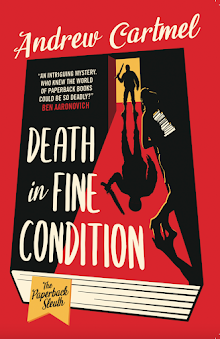 I recently wrote about a superior Poirot novel, and began to get interested in which of his adventures represent the cream of the crop.
I recently wrote about a superior Poirot novel, and began to get interested in which of his adventures represent the cream of the crop.As it happens, the next one I picked up, Mrs McGinty's Dead, the 30th in the series, published in 1952, also qualifies for the top ranking.
The story begins by drawing a more thorough portrait of Poirot, and his inner world, than is usual.The great detective is bored and in need of a challenge. As it happens, one is on its way...
 In the shape of a cop who is sure that an innocent man is facing the gallows. The condemned man is James Bentley, and he was the lodger of one Mrs McGinty, an old woman who was brutally murdered.
In the shape of a cop who is sure that an innocent man is facing the gallows. The condemned man is James Bentley, and he was the lodger of one Mrs McGinty, an old woman who was brutally murdered.Mrs McGinty was a char woman — a woman who cleans people's houses — in a small village called Broadhinny. And the notion of a sleepy, idyllic English village is dismissed very early in the book.
 Superintendent Spence, the cop, says, "Our villages... aren't friendly... Evacuees found that during the war." I imagine Christie had in mind here the savage true life case which inspired her masterpiece The Mousetrap.
Superintendent Spence, the cop, says, "Our villages... aren't friendly... Evacuees found that during the war." I imagine Christie had in mind here the savage true life case which inspired her masterpiece The Mousetrap.And when Poirot goes to Broadhinny to investigate, he is rather a fish out of water. Especially in the dreadful boarding house where he has to stay. The boarding house is run by Mrs Summerhayes (great name), a fun character who is brought emphatically to life in a couple of sentences.

The Summerhayes household is in a state of perpetual chaos... "The cat's been sick again... Those bloody hens are in the larder."
And when our hero tells Mrs Summerhayes that he is Hercule Poirot, expecting awestruck recognition of the great detective, she merely says "lovely name... Greek, isn't it?" Poor Poirot is punctured.
 And when he explains that he's "'Perhaps the most famous detective there is.'" The response is, again, not what he expected:
And when he explains that he's "'Perhaps the most famous detective there is.'" The response is, again, not what he expected:"Mrs Summerhayes screamed with amusement. 'I see you're a great practical joker, M. Poirot'."
 Christie's gift for comedy is seriously
under-appreciated, and this whole sequence is a comic tour de force.
Christie's gift for comedy is seriously
under-appreciated, and this whole sequence is a comic tour de force.But whatever Mrs Summerhayes may think, Poirot has soon begun to make serious progress on the murder of Mrs McGinty, linking the crime to one of four famous murder cases in the past.
 The trouble is, he doesn't know which one...
The trouble is, he doesn't know which one...Incidentally, one of those cases involved "poisoning by a vegetable alkaloid." By now Christie is, or is at least sounding, a lot more expert about her poisons than she was twenty years ago in Peril at End House.
 And then Poirot is
hit by an apple core and suddenly Ariadne Oliver is on the scene, linking up with the great detective for the first time since Cards on the Table. Mrs Oliver is a writer of detective stories and a fun surrogate for Agatha Christie.
And then Poirot is
hit by an apple core and suddenly Ariadne Oliver is on the scene, linking up with the great detective for the first time since Cards on the Table. Mrs Oliver is a writer of detective stories and a fun surrogate for Agatha Christie.Indeed Ariadne reflects regretfully on how in one of her books she blundered about pharmacology: "I made sulphanol soluble in water." Here one senses a mea culpa from Christie for her own heroin quills and cocaine chocolates.

The presence of Ariadne as a subsidiary investigator really peps things up, and the story is given even more energy when Poirot acquires another helper in the form of a young woman who is enlisted to assist him, much as Jane Grey did in Death in the Clouds.
 In this case it is the glamorous Maude Williams, whom Poirot sends undercover as a maid in a posh household. Maude has a great line in sarcastic wit and refers to her bosses as "old frozen fish" and "Her Acidity".
In this case it is the glamorous Maude Williams, whom Poirot sends undercover as a maid in a posh household. Maude has a great line in sarcastic wit and refers to her bosses as "old frozen fish" and "Her Acidity".But of course it is Poirot who ultimately cracks the case. And, as always, there is a moment in the story when this silly caricature of a foreigner gets deadly serious.
 "He was no longer a ridiculous little man... he was a hunter very close to his quarry."
"He was no longer a ridiculous little man... he was a hunter very close to his quarry."This is topnotch Christie, fun, fresh and full of vivid characters and witty dialogue.
And it is a distinctive and superior Hercules Poirot novel — indeed it features that very rare occurrence, an attempt on Poirot's own life.
Oh yes, and the solution to the mystery is just beautiful. I never would have guessed it.
(Image credits: The main image with the beautiful, surreal Tom Adams fly is a scan of a copy from my own library. All the others are from Good Reads.)




No comments:
Post a Comment